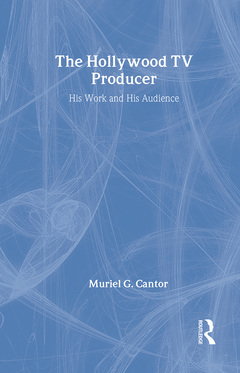The Hollywood TV Producer His Work and His Audience
Auteur : Cantor Muriel G.

Except for accounts of journalists, dissident employees, and an occasional congressional committee focusing on crime and unethical practices, we have known very little about how television programs are produced. The Hollywood TV Producer, originally published in 1971, was the first serious examination of constraints, conflicts, and rewards in the daily lives of television producers. Its insights were important at the time and have not been challenged.
Using as her framework the social system of mass communications, Muriel G. Cantor shows how producers select stories for television series and how movies end up in prime time. In order to get a comprehensive look at the inner workings of the TV industry and its producers, the author interviewed eighty producers in Hollywood over a two-season period. She probed to discover how the people producers work for and where they work influences their decision-making.
As Cantor shows, critics of television who suggest that to remain in production, a producer must first please the business organization that finances his or her operations, are largely correct. Cantor shows that content is determined by a combination of artistic and professional factors, as well as social, economic, and political norms that have developed over time in the industry.
Foreword
Preface
Introduction to the Transaction Edition
1. Introduction
2. Social Criticism and Sociological Theory
3. The Work Setting
4. The Producer: His Training and Commitment
5. The Producer and His Role Partners: Writers, Directors, and Actors
6. The Producer and the Network: Professional versus Bureaucracy
7. The Producer, Network Control, and Violence
8. Summary and Conclusion
9. The Producer and the Viewing Audience
Appendix A The Interview Schedule
Appendix B The Television Code, Sections I–IV
Appendix C The Nielsen Ratings
Appendix D Background Characteristics of Producers
References Cited
Index
Date de parution : 01-1988
Date de parution : 05-2015
15.2x22.9 cm
Thèmes de The Hollywood TV Producer :
Mots-clés :
Television Producers Association; free; Writers Guild Strike; lance; Saturday Morning Shows; Free Lance Writing; Young Man; Pilot Film; Reference Group Orientations; Network Approval; Story Editor; Saturday Morning Programming; Producers Guild; Television Film Making; Network Interference; Nielsen Ratings; Craft Aspects; Writers Guild; Main Character; Dramatic Anthology; Apprenticeship Route; Unsolicited Commercial Messages; Girl Friend; Specialized Role Skills; Reference Group Theory; Dick Daring; Feature Film Directing



